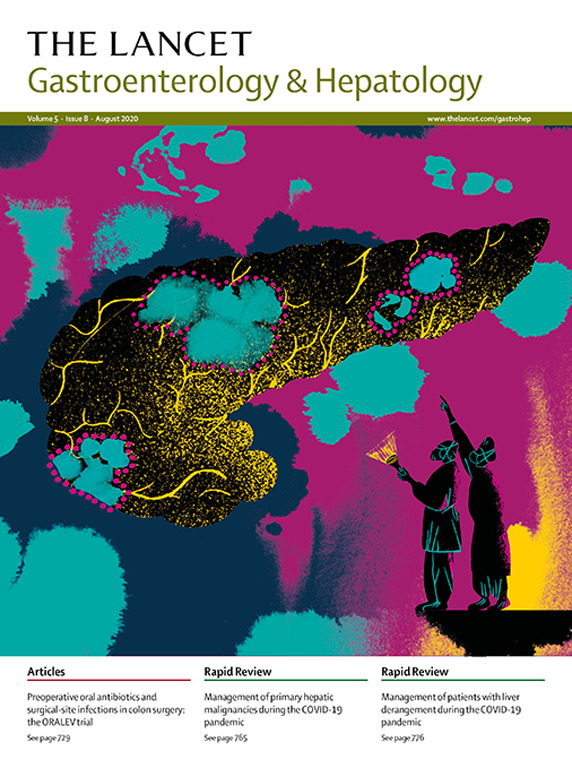Efficacy and safety of ervogastat alone and in combination with clesacostat in patients with biopsy-confirmed metabolic dysfunction-associated steatohepatitis and F2–F3 fibrosis (MIRNA): results from a phase 2, randomised, double-blind, double-dummy study
IF 38.6
1区 医学
Q1 GASTROENTEROLOGY & HEPATOLOGY
引用次数: 0
Abstract
Background
Ervogastat, a diacylglycerol acyltransferase 2 (DGAT2) inhibitor, and clesacostat, an acetyl-coenzyme A carboxylase (ACC) inhibitor, have shown promise in reducing hepatic steatosis. Increased circulating triglycerides, a mechanistic consequence of ACC inhibitors, has been shown to be downregulated by DGAT2 inhibitor co-administration. We assessed the efficacy and safety of ervogastat alone and ervogastat plus clesacostat in adults with biopsy-confirmed metabolic dysfunction-associated steatohepatitis (MASH) and fibrosis stage 2 or 3.Methods
This phase 2 double-blind, double-dummy, randomised study was conducted at 198 clinical sites across 11 countries. A computer-generated randomisation code (random permuted blocks method) was used to allocate patients to treatment groups in equal ratios, and stratified based on degree of fibrosis (F2 vs F3), using an interactive response technology system to ervogastat (25 mg, 75 mg, 150 mg, or 300 mg), ervogastat plus clesacostat (150 mg plus 5 mg or 300 mg plus 10 mg), or placebo, twice daily for 48 weeks. The primary endpoint was the proportion of patients achieving MASH resolution without fibrosis worsening, at least 1 stage fibrosis improvement without MASH worsening, or both, at week 48. Patients were analysed according to the treatment group they were assigned to. The primary endpoint was analysed based on the full analysis set (all randomly assigned patients who took at least one dose of study treatment who provided evaluable baseline biopsy data) in which patients missing a week 48 biopsy were considered non-responders. This completed trial was registered with ClinicalTrials.gov (NCT04321031).Findings
Recruitment began June 15, 2020; randomisation was completed Feb 22, 2023, with 255 patients randomly assigned and given treatment (73% of planned sample size; ervogastat 25 mg: N=35; ervogastat 75 mg: N=48; ervogastat 150 mg: N=42; ervogastat 300 mg: N=31; ervogastat 150 mg plus clesacostat 5 mg: N=35; ervogastat 300 mg plus clesacostat 10 mg: N=30; placebo: N=34). 13 (38%) patients in the placebo group achieved the composite primary endpoint, as did 16 (46%) in the ervogastat 25 mg group (difference from placebo in the proportion of patients achieving the primary endpoint 0·08 [90% CI –0·11 to 0·27]), 25 (52%) in the ervogastat 75 mg group (0·14 [–0·04 to 0·32]), 21 (50%) in the ervogastat 150 mg group (0·12 [–0·07 to 0·30]), and 14 (45%) in the ervogastat 300 mg group (0·07 [–0·12 to 0·27]). 23 (66%) patients in the ervogastat 150 mg plus clesacostat 5 mg group (difference from placebo 0·27 [90% CI 0·07 to 0·43]) and 19 (63%) of those in the ervogastat 300 mg plus clesacostat 10 mg group (0·25 [0·04 to 0·42]) achieved the composite primary endpoint. Thus, the primary endpoint was not met by any doses of ervogstat alone, but was met by both dose levels of ervogastat plus clesacostat. All experimental groups showed greater effects on MASH resolution without worsening of fibrosis than with placebo alone; improvement in fibrosis by one stage or more without worsening of MASH was not greater in any experimental group compared with placebo. Most adverse events were mild or moderate in severity and did not increase in frequency or severity with increasing dose; however, ervogastat plus clesacostat was associated with a likely undesirable fasting lipid and apolipoprotein profile. The most common adverse event was inadequate control of diabetes (placebo: 4/34 [12%]; ervogastat 25 mg: 6/35 [17%]; ervogastat 75 mg: 5/48 [10%]; ervogastat 150 mg: 3/42 [7%]; ervogastat 300 mg: 2/31 [6%]; ervogastat 150 mg plus clesacostat 5 mg: 2/35 [6%]; ervogastat 300 mg plus clesacostat 10 mg: 2/30 [7%]). There were no fatal events; 19/255 (7%) patients reported 20 serious adverse events (placebo: 1/34 [3%]; ervogastat 25 mg: 1/35 [3%]; ervogastat 75 mg: 5/48 [10%]; ervogastat 150 mg: 1/42 [2%]; ervogastat 300 mg: 4/31 [13%]; ervogastat 150 mg plus clesacostat 5 mg: 5/35 [14%]; ervogastat 300 mg plus clesacostat 10 mg: 2/30 [7%]).Interpretation
The combined efficacy, safety, and tolerability data with ervogastat supports continued investigation for its use in MASH. Larger and longer trials are needed to further assess ervogastat and ervogastat plus clesacostat for MASH treatment.Funding
Pfizer.ervogastat单用和联合clesacostat治疗活检证实的代谢功能障碍相关脂肪性肝炎和F2-F3纤维化(MIRNA)患者的疗效和安全性:来自一项随机、双盲、双虚拟的2期研究结果
研究背景:二酰基甘油酰基转移酶2 (DGAT2)抑制剂德伏加司他和乙酰辅酶a羧化酶(ACC)抑制剂康塞司他在减少肝脂肪变性方面表现出良好的前景。增加循环甘油三酯,ACC抑制剂的一个机制后果,已被证明是下调DGAT2抑制剂共同施用。我们对活组织检查证实为代谢功能障碍相关性脂肪性肝炎(MASH)和纤维化2期或3期的成人患者单独使用胃胃司他和联合使用胃胃司他的疗效和安全性进行了评估。该2期双盲、双虚拟、随机研究在11个国家的198个临床点进行。使用计算机生成的随机化代码(随机排列块法)将患者按相同比例分配到治疗组,并根据纤维化程度(F2 vs F3)进行分层,使用ervogastat (25mg, 75mg, 150mg或300mg), ervogastat加clesacstat (150mg加5mg或300mg加10mg)或安慰剂的交互反应技术系统,每天两次,持续48周。主要终点是在第48周达到MASH缓解而无纤维化恶化的患者比例,至少1期纤维化改善而无MASH恶化,或两者兼而有之。根据患者被分配到的治疗组对患者进行分析。主要终点是基于完整的分析集(所有随机分配的患者,接受至少一个剂量的研究治疗,并提供可评估的基线活检数据)进行分析,其中48周未进行活检的患者被认为无反应。该完成的试验已在ClinicalTrials.gov注册(NCT04321031)。招聘开始于2020年6月15日;随机化于2023年2月22日完成,255名患者被随机分配并接受治疗(计划样本量的73%;胃泌素25 mg: N=35;ervoogastat 75 mg: N=48;ervoogastat 150 mg: N=42;ervoogastat 300 mg: N=31;ervoogastat 150 mg + clesacostat 5 mg: N=35;ervoogast300 mg + clesacostat 10 mg: N=30;安慰剂:N = 34)。安慰剂组中有13例(38%)患者达到了复合主要终点,ervogastat 25 mg组中有16例(46%)患者达到了主要终点(与安慰剂组的差异在于达到主要终点的患者比例为0.08 [90% CI - 0.11至0.27]),ervogastat 75 mg组中有25例(52%)患者达到了主要终点(0.14[- 0.04至0.32]),ervogastat 150 mg组中有21例(50%)患者达到了主要终点(0.12[- 0.07至0.30]),ervogastat 300 mg组中有14例(45%)患者达到了主要终点(0.07至0.27))。ervogastat 150 mg + clesacostat 5 mg组中有23例(66%)患者达到了复合主要终点(与安慰剂相比差异为0.27 [90% CI 0.07 ~ 0.43]), ervogastat 300 mg + clesacostat 10 mg组中有19例(63%)患者达到了复合主要终点(0.25[0.04 ~ 0.42])。因此,单独使用任何剂量的胃泌司他都不能达到主要终点,但两种剂量水平的胃泌司他加塞司他都可以达到主要终点。所有实验组均显示,与单独使用安慰剂相比,在没有纤维化恶化的情况下,对MASH的缓解效果更大;与安慰剂组相比,任何实验组的纤维化改善一期或以上,而MASH没有恶化。大多数不良事件的严重程度为轻度或中度,并且不随剂量的增加而增加频率或严重程度;然而,ervogastat加clesacostat可能与不希望的空腹脂质和载脂蛋白谱相关。最常见的不良事件是糖尿病控制不足(安慰剂:4/34 [12%];Ervogastat 25 mg: 6/35 [17%];Ervogastat 75mg: 5/48 [10%];Ervogastat 150 mg: 3/42 [7%];Ervogastat 300 mg: 2/31 [6%];Ervogastat 150 mg + clesacostat 5 mg: 2/35 [6%];Ervogastat 300 mg + clesacostat 10 mg: 2/30[7%])。没有致命的事件;19/255(7%)例患者报告了20例严重不良事件(安慰剂:1/34 [3%];Ervogastat 25 mg: 1/35 [3%];Ervogastat 75mg: 5/48 [10%];Ervogastat 150 mg: 1/42 [2%];Ervogastat 300 mg: 4/31 [13%];Ervogastat 150 mg + clesacostat 5 mg: 5/35 [14%];Ervogastat 300 mg + clesacostat 10 mg: 2/30[7%])。解释:胃能司他的综合疗效、安全性和耐受性数据支持继续研究其在MASH中的应用。需要更大规模和更长时间的试验来进一步评估胃能司他和胃能司他加塞司他用于MASH治疗。
本文章由计算机程序翻译,如有差异,请以英文原文为准。
求助全文
约1分钟内获得全文
求助全文
来源期刊

Lancet Gastroenterology & Hepatology
Medicine-Hepatology
CiteScore
50.30
自引率
1.10%
发文量
0
期刊介绍:
The Lancet Gastroenterology & Hepatology is an authoritative forum for key opinion leaders across medicine, government, and health systems to influence clinical practice, explore global policy, and inform constructive, positive change worldwide.
The Lancet Gastroenterology & Hepatology publishes papers that reflect the rich variety of ongoing clinical research in these fields, especially in the areas of inflammatory bowel diseases, NAFLD and NASH, functional gastrointestinal disorders, digestive cancers, and viral hepatitis.
 求助内容:
求助内容: 应助结果提醒方式:
应助结果提醒方式:


